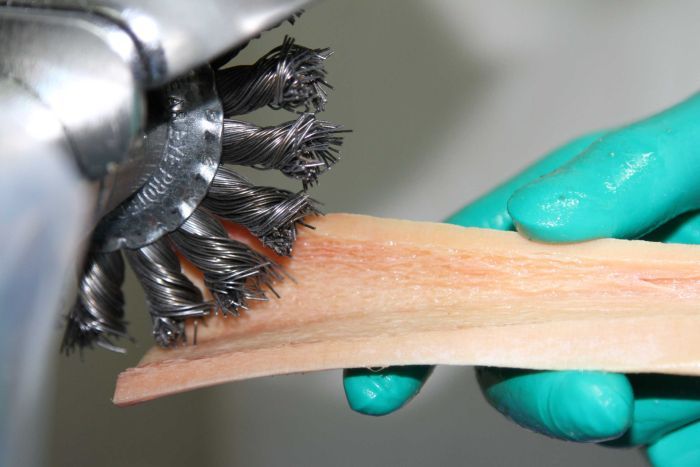Bones from hip replacement transplants give new life (ABC Australia)
In the business of bone donation, old hips are giving new life to people needing reconstructive surgery.
More than 33,000 hip replacements are performed each year in Australia.
If the patient ticks the bone donation box, part of the hip is taken away to be processed and turned into bone grafts.
When a hip is replaced, the ball at the top of the hip joint, the femoral head, is removed and a plastic socket put in its place.
In New South Wales, just 600 out of 6,000 hip replacement patients last year agreed to become living donors.
While the number remains low, it represents a steady increase.
Sharon Bryce from the Australian Tissue Donation Network said the majority of people are not aware of bone donation.
“You see bone from people in their 60s and 70s and 80s being used for example to transplant into children who are having spinal surgery,” Ms Bryce said. “So children as young as two or three years of age are actually recycling or re-using bone from older people.”
Old hips give new life
 PHOTO: Bernard Lamerton became a living bone donor when he had hip replacement surgery. (ABC: Ginny Stein)
PHOTO: Bernard Lamerton became a living bone donor when he had hip replacement surgery. (ABC: Ginny Stein)Bernard Lamerton said the decision to become a living bone donor took no time at all to make.
“I just thought it was a given, I will certainly do it. I was happy to do it, I never gave it a second thought. I was always going to do it,” he said.
On the day he was told he needed a hip replacement, his surgeon, Professor Warwick Bruce, presented him with two other options.
“I told him he could help two to four other people by donating his femoral head, which would otherwise be thrown out,” Professor Bruce said.
Professor Warwick Bruce uses donated bone and tissue in a range of reconstructive procedures, from knee reconstructions through to children having spinal surgery to repair scoliosis or curvature of the spine.
He has been at the forefront of promoting bone donation for decades.
“I actually had the first bone bank in Sydney in 1984,” he said. “A patient died in the hospital and I asked permission and I harvested all their bones. It kept me in bone for about three or four years.”
With bone and tissue grafts the second most performed procedure after a blood transfusion, there is now a push to raise awareness about what it means to become a donor.
Crunch: Milled up bone fills gaps
Lateline was given a rare glimpse into a world few outsiders have ever seen.
Simon Berry is the CEO of Australian Biotechnologies, a laboratory in northern Sydney where donated bone is recycled for use in surgery.
At the lab, a team of specialist technicians carry out what is a very niche trade.
Donated bone from living and deceased donors is shaped into blocks or plugs for ready use in surgery.
“The surgeons prefer this tissue because it replicates the natural healing properties of the patient’s own bone, and effectively it remodels into the patients’ own bone over a six to 12-month period,” said Mr Berry.
It is also ground down into a product aptly named Crunch, to fill in the gaps and help healing after surgery. “Crunch is effectively milled up bone to a certain granulated size.
“We use a special process to clean and then sterilize that bone, and that can be used in surgery such as orthopaedic and spinal surgery.”
In the past decade 25,000 Australians have benefited from bone grafts manufactured in the Australian Biotechnologies lab.
‘It’s worked amazingly’
Natalia Lisowski is 15 years old and dreams of becoming a professional footballer.
Earlier this year, she began to doubt she was capable of pursuing her dream when she started to struggle to breathe.
“I was really scared just because I thought there was something that could go wrong and prevent me from doing things that I love like playing soccer. I was terrified,” she said.
She underwent surgery with donated bone used to repair her scoliosis.
Three months after her surgery, she has now been given the all clear to start playing again.
“It has worked so well. I don’t have much pain anymore.
“I’m back to doing almost everything I used to do, it’s worked amazingly.”


